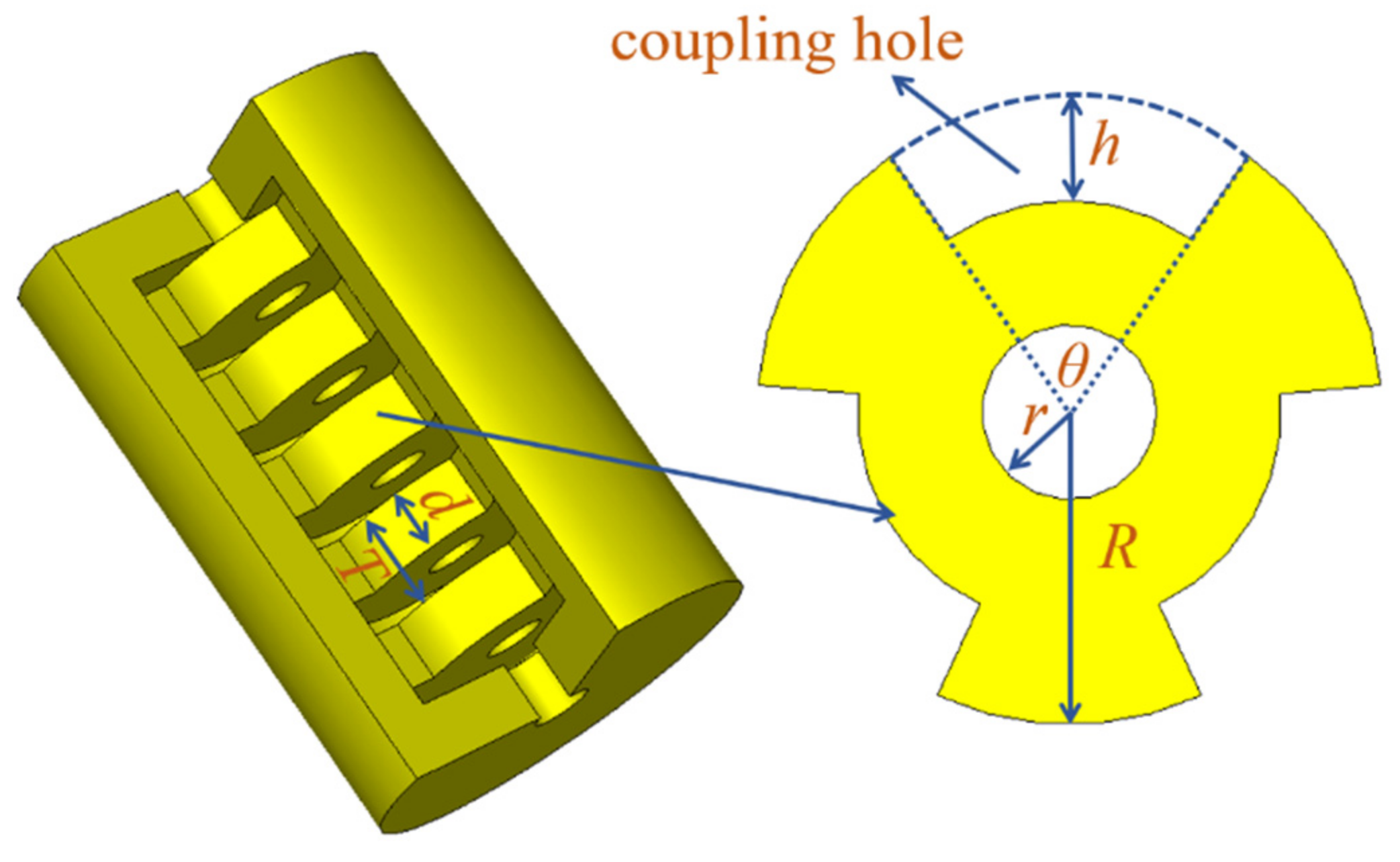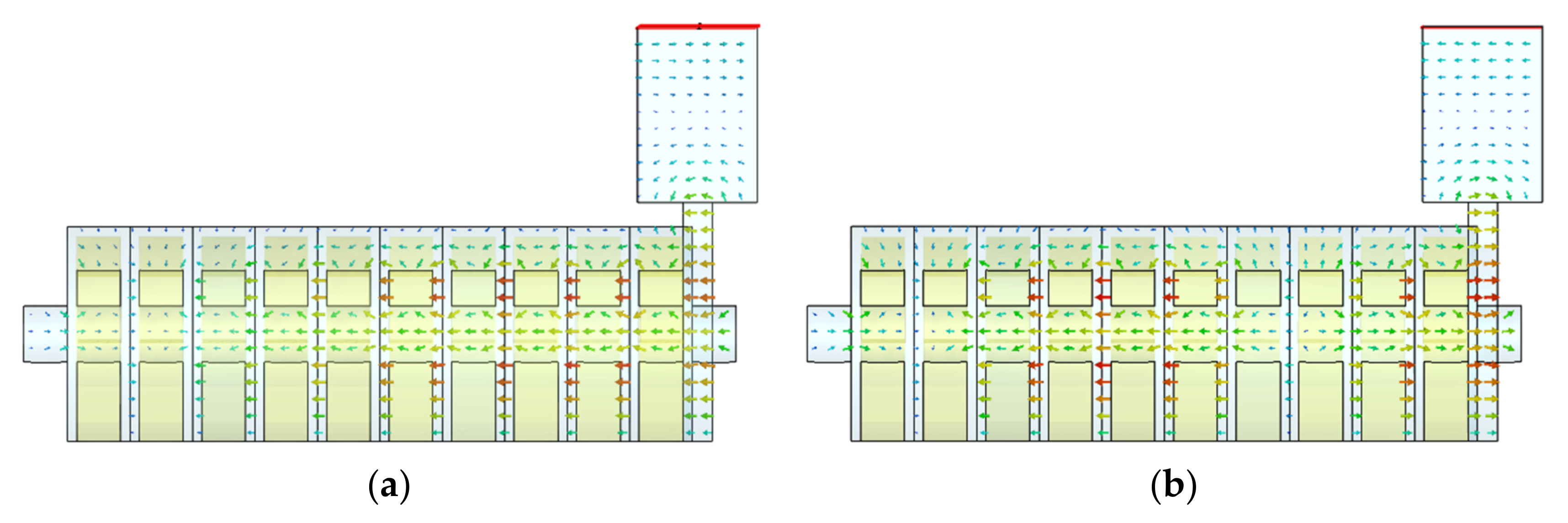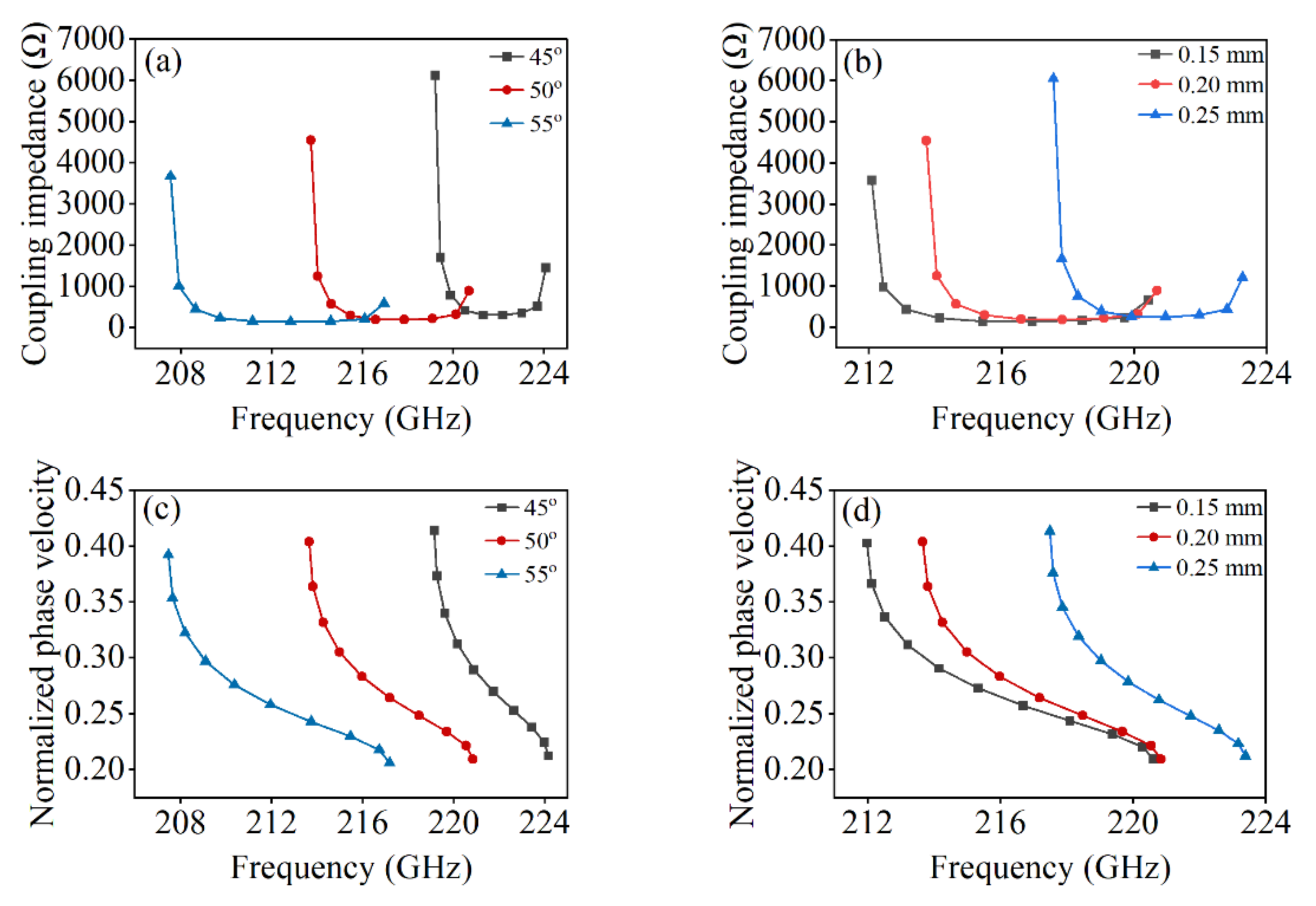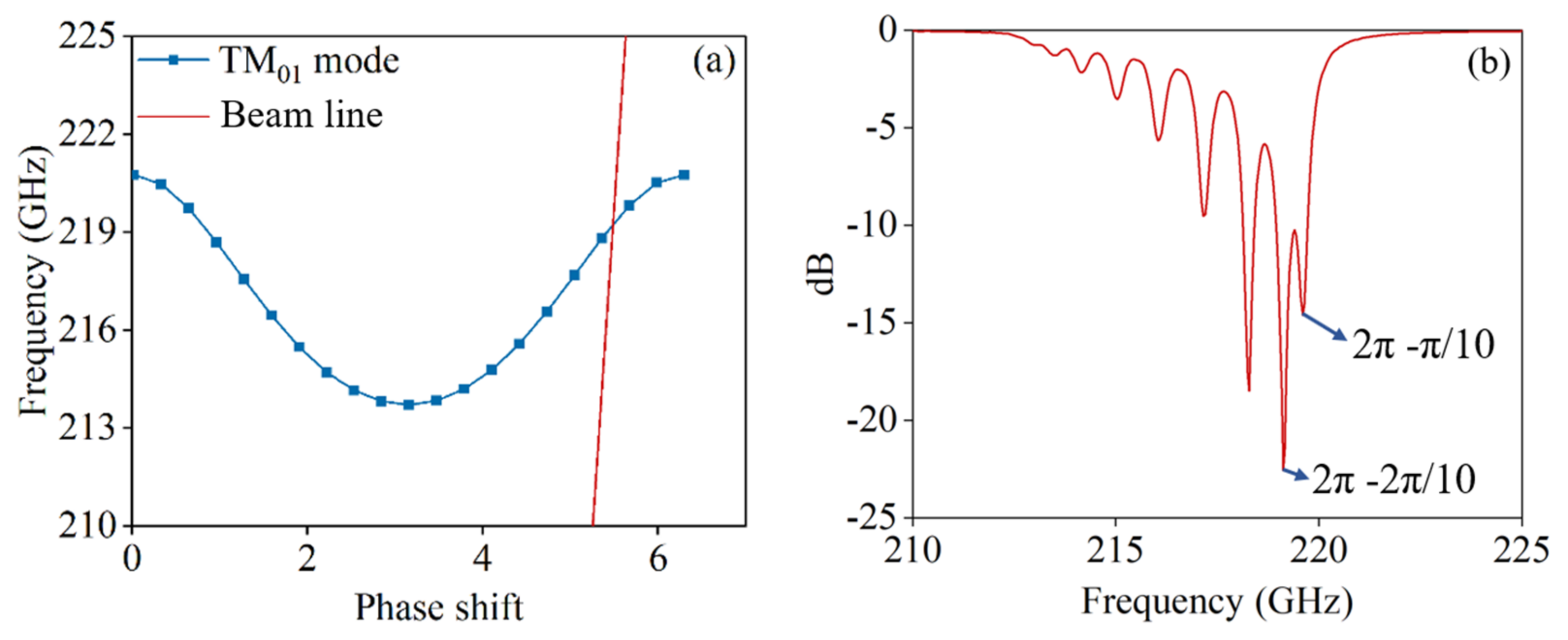G-Band Broad Bandwidth Extended Interaction Klystron with Traveling-Wave Output Structure
Abstract
:1. Introduction
2. Design and Simulation of the Beam-Wave Interaction Structure
2.1. Cluster Cavities Design
2.2. Traveling Wave Output Structure Design
3. PIC Simulation Results
4. Conclusions
Author Contributions
Funding
Conflicts of Interest
References
- Mumtaz, S.; Choi, E.H. An efficient vircator with high output power and less drifting electron loss by forming multi virtual cathodes. IEEE Electron. Device Lett. 2022, 43, 1756–1759. [Google Scholar] [CrossRef]
- Mumtaz, S.; Uhm, H.; Lim, J.S.; Choi, E.H. Output-Power Enhancement of Vircator Based on Second Virtual Cathode Formed by Wall Charge on a Dielectric Reflector. IEEE Trans. Electron. Devices 2022, 69, 2043–2050. [Google Scholar] [CrossRef]
- Dubinov, A.E.; Saikov, S.K.; Tarakanov, V.P. Multivircator as a New Highly Effective Microwave Generator with Multiple Virtual Cathodes: Concept and PIC-Simulation. IEEE Trans. Plasma Sci. 2020, 48, 141–145. [Google Scholar] [CrossRef]
- Booske, J.H.; Dobbs, R.J.; Joye, C.D.; Kory, C.L.; Neil, G.R.; Park, G.-S.; Park, J.; Temkin, R.J. Vacuum Electronic High Power Terahertz Sources. IEEE Trans. Terahertz Sci. Technol. 2011, 1, 54–75. [Google Scholar] [CrossRef]
- Ulisse, G.; Krozer, V. W-Band Traveling Wave Tube Amplifier Based on Planar Slow Wave Structure. IEEE Electron. Device Lett. 2017, 38, 126–129. [Google Scholar] [CrossRef]
- Shin, Y.M.; Wang, J.X.; Barnett, L.R.; Luhmann, N.C. Particle-In-Cell Simulation Analysis of a Multicavity W-Band Sheet Beam Klystron. IEEE Trans. Electron. Devices 2011, 58, 251–258. [Google Scholar] [CrossRef]
- Carr, G.L.; Martin, M.C.; Mckinney, W.R.; Jordan, K.; Neil, G.; Williams, G. Very high Power THz radiation from Relativistic Electrons. In Proceedings of the Twenty Seventh International Conference on Infrared and Millimeter Waves, San Diego, CA, USA, 26 September 2002; Volume 420, pp. 153–156. [Google Scholar]
- Liu, W.; Zhang, Z.; Zhao, C.; Guo, X.; Zhang, Z.; Liao, S. Development of a Subterahertz Folded-Waveguide Extended Interaction Oscillator. IEEE Trans. Plasma Sci. 2017, 45, 1731–1738. [Google Scholar] [CrossRef]
- Li, R.; Ruan, C.; Zhang, H.; Fahad, A.K.; Shan, S.; He, Y. Optimization and improvement of output performance in G-band extended interaction klystron. J. Infrared Millim. Terahertz Waves 2018, 40, 5–16. [Google Scholar] [CrossRef]
- Zhang, C.Q.; Ruan, C.J.; Wang, S.Z.; Yang, X.Y. High-power extended-interaction klystron with ladder-type structure. J. Infrared Millim. Waves 2015, 34, 307–313. [Google Scholar]
- Li, S.; Ruan, C.; Fahad, A.K.; Wang, P.; Zhang, Z.; He, W. Novel Coupling Cavities for Improving the Performance of G-Band Ladder-Type Multigap Extended Interaction Klystrons. IEEE Trans. Plasma Sci. 2020, 48, 1350–1356. [Google Scholar] [CrossRef]
- Chernin, D.; Burke, A.; Chernyavskiy, I.; Petillo, J.; Dobbs, R.; Roitman, A.; Horoyski, P.; Hyttinen, M.; Berry, D.; Blank, M.; et al. Extended Interaction Klystrons for terahertz power amplifiers. In Proceedings of the 2010 IEEE International Vacuum Electronics Conference, Monterey, CA, USA, 18–20 May 2010. [Google Scholar]
- Chodorow, M.; Wessel-Berg, T. A High-Efficiency Klystron with Distributed Interaction. IRE Trans. Electron. Devices 1961, 8, 44–55. [Google Scholar] [CrossRef]
- Harvey, W.; Tope, M.; Esteban-Fernandez, D.; Roitman, A.; Sokol, E.; Berry, D. Development path of a Ka-Band Extended Interaction Klystron for space-borne interferometer. In Proceedings of the 2016 IEEE International Vacuum Electronics Conference, Monterey, CA, USA, 19–21 April 2016. [Google Scholar]
- Roitman, A.; Horoyski, P.; Hyttinen, M.; Roitman, A.; Steer, B. Extended Interaction Klystrons for Submillimeter Applications. In Proceedings of the 2006 IEEE International Vacuum Electronics Conference held Jointly with 2006 IEEE International Vacuum Electron Sources, Monterey, CA, USA, 25–27 April 2006. [Google Scholar]
- Nguyen, K.T.; Pasour, J.; Wright, E.L.; Pershing, D.E.; Levush, B. Design of a G-band sheet-beam Extended-Interaction Klystron. In Proceedings of the 2009 IEEE International Vacuum Electronics Conference, Rome, Italy, 28–30 April 2009. [Google Scholar]
- Pasour, J.; Wright, E.; Nguyen, K.T.; Balkcum, A.; Wood, F.N.; Myers, R.E.; Levush, B. Demonstration of a Multikilowatt, Solenoidally Focused Sheet Beam Amplifier at 94 GHz. IEEE Trans. Electron. Devices 2014, 61, 1630–1636. [Google Scholar] [CrossRef]
- Zeng, Z.; Zhou, L.; Li, W.; Chen, H. Design and optimization of a W-band extended interaction klystron amplifier. In Proceedings of the 2015 IEEE International Vacuum Electronics Conference (IVEC), Beijing, China, 27–29 April 2015. [Google Scholar]
- Ding, Y.G. Design, Manufacture and Application of High Power Klystron; National Defense Industry: Beijing, China, 2010; pp. 61–68. [Google Scholar]
- Li, R.; Ruan, C.; Zhang, H.; Haq, T.U.; He, Y.; Shan, S. Theoretical Design and Numerical Simulation of Beam-Wave Interaction for G-Band Unequal-Length Slots EIK with Rectangular Electron Beam. IEEE Trans. Electron. Devices 2018, 65, 3500–3506. [Google Scholar] [CrossRef]
- Zhang, F.; Zhao, Y.; Ruan, C. A High-Power and Broadband G-Band Extended Interaction Klystron Based on Mode Overlap. IEEE Trans. Electron. Devices 2022, 69, 4611–4616. [Google Scholar] [CrossRef]
- Ding, Y.G. Theory and Computer Simulation of High Power Klystron; National Defense Industry Press: Beijing, China, 2008; pp. 44–47. [Google Scholar]
- Ding, Y.G.; Niu, X.H.; Li, D.K. A S-band 2.5 MW high-power broadband klystron. J. Electron. Inf. Technol. 1985, 7, 247–253. [Google Scholar]
- Xu, X.; Yuan, X.; Li, H.; Chen, Q.; Zu, Y.; Cole, M.; Xie, J.; Yin, Y.; Yan, Y. Design of a G-Band Extended Interaction Klystron Based on a Three-Coupling-Hole Structure. IEEE Trans. Electron. Devices 2022, 69, 1368–1373. [Google Scholar] [CrossRef]
- Ao, X.; Linlin, H.; Lei, Y. Design and machining of components of 0.22 THz folded waveguide traveling wave tube. Qiangjiguang Yu Lizishu 2012, 24, 2135–2140. [Google Scholar]
- Zhang, L.; Wei, Y.; Guo, G.; Ding, C.; Wang, Y.; Jiang, X.; Zhao, G.; Xu, J.; Wang, W.; Gong, Y. A Ridge-Loaded Sine Waveguide for G-Band Traveling-Wave Tube. IEEE Trans. Plasma Sci. 2016, 44, 2832–2837. [Google Scholar] [CrossRef]
- Nayek, N.; Joshi, M.K.; Sonkar, R.K.; Tiwari, T.; Bhattacharjee, R. Design and Analysis of Width-Modulated Two-Section Sine Waveguide for G-Band Traveling-Wave Tube. IEEE Trans. Electron. Devices 2021, 68, 6458–6464. [Google Scholar] [CrossRef]








| Input Cavity | Intermediate Cavity 1 | Intermediate Cavity 2 | Intermediate Cavity 3 | Output Structure | |
|---|---|---|---|---|---|
| h (mm) | 0.2 | 0.2 | 0.2 | 0.2 | 0.2 |
| θ | 50° | 50° | 50° | 50° | 50° |
| d (mm) | 0.216 | 0.22 | 0.217 | 0.219 | 0.2 |
| R (mm) | 0.494 | 0.494 | 0.492 | 0.491 | 0.49 |
| T (mm) | 0.32 | 0.32 | 0.32 | 0.32 | 0.285 |
| r (mm) | 0.13 | ||||
| Input Cavity | Intermediate Cavity 1 | Intermediate Cavity 2 | Intermediate Cavity 3 | |
|---|---|---|---|---|
| f (GHz) | 219.7 | 219.15 | 220.37 | 220.73 |
| Q0 | 750 | 421 | 433 | 418 |
| Qe | 176 | ∞ | ∞ | ∞ |
| M2(R/Q)(Ge/G0) (Ω) | 2.2 | 7.2 | 6.9 | 6.9 |
Publisher’s Note: MDPI stays neutral with regard to jurisdictional claims in published maps and institutional affiliations. |
© 2022 by the authors. Licensee MDPI, Basel, Switzerland. This article is an open access article distributed under the terms and conditions of the Creative Commons Attribution (CC BY) license (https://creativecommons.org/licenses/by/4.0/).
Share and Cite
Xu, X.; Li, H.; Yuan, X.; Chen, Q.; Zu, Y.; Li, H.; Yin, Y.; Yan, Y. G-Band Broad Bandwidth Extended Interaction Klystron with Traveling-Wave Output Structure. Electronics 2022, 11, 3153. https://doi.org/10.3390/electronics11193153
Xu X, Li H, Yuan X, Chen Q, Zu Y, Li H, Yin Y, Yan Y. G-Band Broad Bandwidth Extended Interaction Klystron with Traveling-Wave Output Structure. Electronics. 2022; 11(19):3153. https://doi.org/10.3390/electronics11193153
Chicago/Turabian StyleXu, Xiaotao, Hengliang Li, Xuesong Yuan, Qingyun Chen, Yifan Zu, Hailong Li, Yong Yin, and Yang Yan. 2022. "G-Band Broad Bandwidth Extended Interaction Klystron with Traveling-Wave Output Structure" Electronics 11, no. 19: 3153. https://doi.org/10.3390/electronics11193153
APA StyleXu, X., Li, H., Yuan, X., Chen, Q., Zu, Y., Li, H., Yin, Y., & Yan, Y. (2022). G-Band Broad Bandwidth Extended Interaction Klystron with Traveling-Wave Output Structure. Electronics, 11(19), 3153. https://doi.org/10.3390/electronics11193153






